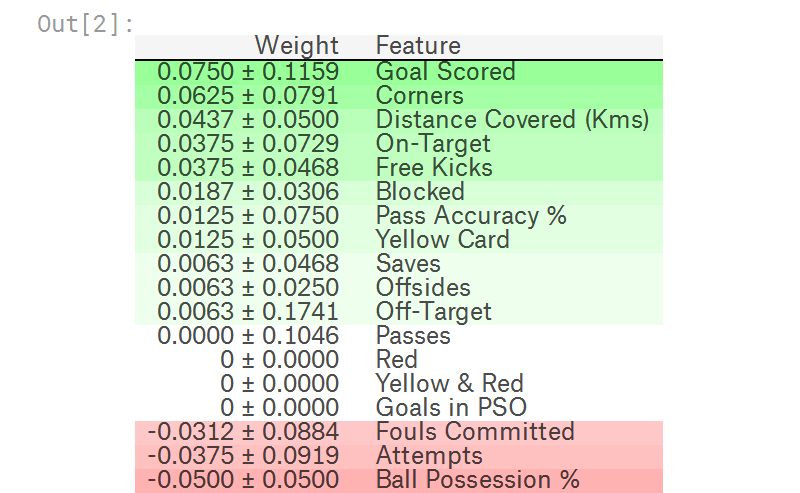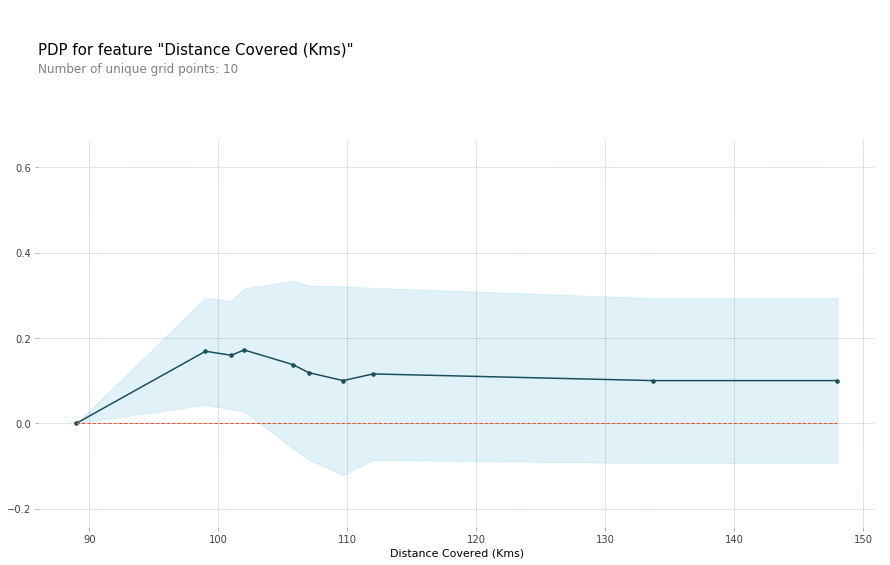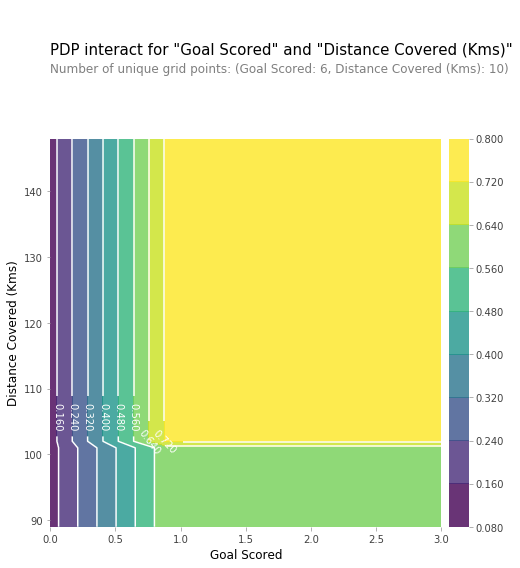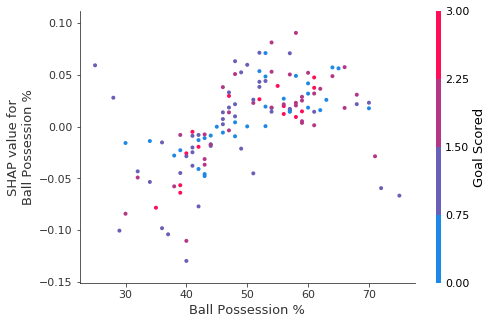学习小记: Kaggle Learn - Machine Learning Explainability
| Method | Feature(s) | Sample(s) | Result Value/Feature |
| Permutation Importance | 1 | all validation samples | Single Scale |
| Partial Dependence Plots | 1~2 | all validation samples | Vector(reasults vs feature) |
| SHAP Values | N | individual sample | 每个feature对当前结果的贡献(相对于baseline) |
| Advanced Uses of SHAP Values - Summary Plots | N | all | 绘制每个feature在每个样本预测结果中的贡献(相对于baseline) |
| Advanced Uses of SHAP Values - SHAP Dependence Contribution Plots | 2 | all | 绘制2个feature在所有样本也测结果中的贡献(相对于baseline) |
参考: https://www.kaggle.com/learn/machine-learning-explainability
这个课程将讲解如何从复杂的机器学习模型中解释这些发现。
- 模型认为数据中的哪些特征是最重要的?
- 对于来自模型的任何单个预测,数据中的每个特性如何影响该特定预测
- 每个特性如何影响模型的整体预测(当考虑大量可能的预测时,它的典型影响是什么?)
这些发现有许多用途,包括
- 调试,理解模型所发现的模式将帮助您识别那些与您对真实世界的认识不一致的地方
- 为特征工程提供信息
- 指导未来的数据收集
- 为人的决策提供信息
- 建立信任,提高产品在用户中的接受度。
Permutation Importance置换重要性
统计每个feature的重要程度,训具体步骤如下:
- 正常训练完模型。
- 对原始validation数据,依次shuffle每个feature的原始数据。
- 根据得到的模型参数,对shuffle后的数据进行预测,计算性能(准确度)下降程度。
- 对每个feature重复2-3,最后得出每个feature的重要程度(shuffle它后性能下降程度)
用eli5库实现的置换重要性计算
import numpy as np import pandas as pd from sklearn.model_selection import train_test_split from sklearn.ensemble import RandomForestClassifier data = pd.read_csv('../input/fifa-2018-match-statistics/FIFA 2018 Statistics.csv') y = (data['Man of the Match'] == "Yes") # Convert from string "Yes"/"No" to binary feature_names = [i for i in data.columns if data[i].dtype in [np.int64]] X = data[feature_names] train_X, val_X, train_y, val_y = train_test_split(X, y, random_state=1) my_model = RandomForestClassifier(random_state=0).fit(train_X, train_y)
import eli5 from eli5.sklearn import PermutationImportance perm = PermutationImportance(my_model, random_state=1).fit(val_X, val_y) eli5.show_weights(perm, feature_names = val_X.columns.tolist())
官方例程输出如下,其中排在前面的是更重要的feature,排在后面的是不那么重要的feature,最后偶然出现负数,也是正常现象。
毕竟是shuffle feature data,对一些不太重要的feature,偶尔出现shuffle后比shuffle前更准确也时有发生。

Partial Dependence Plots
用于统计feature(s)如何影响predictions,用pdpbox库
单个feature的影响
# Build Random Forest model rf_model = RandomForestClassifier(random_state=0).fit(train_X, train_y) pdp_dist = pdp.pdp_isolate(model=rf_model, dataset=val_X, model_features=feature_names, feature=feature_to_plot) pdp.pdp_plot(pdp_dist, feature_to_plot) plt.show()

两个features的组合影响
# Similar to previous PDP plot except we use pdp_interact instead of pdp_isolate and pdp_interact_plot instead of pdp_isolate_plot features_to_plot = ['Goal Scored', 'Distance Covered (Kms)'] inter1 = pdp.pdp_interact(model=tree_model, dataset=val_X, model_features=feature_names, features=features_to_plot) pdp.pdp_interact_plot(pdp_interact_out=inter1, feature_names=features_to_plot, plot_type='contour') plt.show()

SHAP Values, SHapley Additive exPlanations
对于特定sample的预测,解释每个feature在其中的影响,正负都有。
可用于:
- 一个模型说银行不应该借钱给别人,法律要求银行解释每笔贷款被拒的原因。
- 医疗服务提供者想要确定,是什么因素导致了每个病人患某些疾病的风险,这样他们就可以通过有针对性的健康干预,直接解决这些风险因素
使用shap库,代码片段如下,其中KernelExplainer 结果和TreeExplainer不完全一样,但是比较接近,结果中表达的意思相同。
import shap # package used to calculate Shap values # Create object that can calculate shap values explainer = shap.TreeExplainer(my_model) # Calculate Shap values shap_values = explainer.shap_values(data_for_prediction) shap.initjs() shap.force_plot(explainer.expected_value[1], shap_values[1], data_for_prediction) # use Kernel SHAP to explain test set predictions k_explainer = shap.KernelExplainer(my_model.predict_proba, train_X) k_shap_values = k_explainer.shap_values(data_for_prediction) shap.force_plot(k_explainer.expected_value[1], k_shap_values[1], data_for_prediction)
运行结果的图表类似如下图形,
- 其中左边(红色)代表当前样本相对于baseline增加的预测值
- 右边(蓝色)代表当前样本相对于baseline减少的预测值
- 左边(红色) - 右边(蓝色) => output_value - base_value

Advanced Uses of SHAP Values
Summary Plots
import shap # package used to calculate Shap values # Create object that can calculate shap values explainer = shap.TreeExplainer(my_model) # calculate shap values. This is what we will plot. # Calculate shap_values for all of val_X rather than a single row, to have more data for plot. shap_values = explainer.shap_values(val_X) # Make plot. Index of [1] is explained in text below. shap.summary_plot(shap_values[1], val_X)
结果如下图所示:
- 每个点代表一个sample
- 垂直方向是特征
- 水平方向是该特征对应的SHAP Value
- 颜色代表该特征的数值大小

SHAP Dependence Contribution Plots
import shap # package used to calculate Shap values # Create object that can calculate shap values explainer = shap.TreeExplainer(my_model) # calculate shap values. This is what we will plot. shap_values = explainer.shap_values(X) # make plot. shap.dependence_plot('Ball Possession %', shap_values[1], X, interaction_index="Goal Scored")
运行结果图简介:
- 横坐标表示Ball Possession %特征的值
- 纵坐标表示SHAP Value值
- 颜色(如右边注释)表示Goal Scored特征的值






 浙公网安备 33010602011771号
浙公网安备 33010602011771号